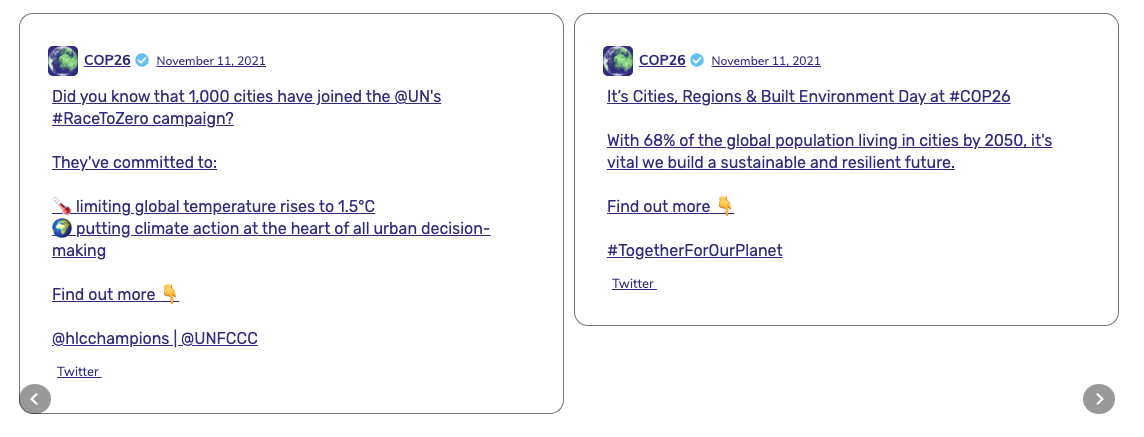Providing alternativesMoving and flashing content
Moving, flashing, blinking, auto-scrolling or auto-updating content is used to increase visual interest or draw and maintain attention. However, these are not generally as accessible as static content.
The following is an image of a carousel from the COP26 website.

Auto-scrolling and auto-updating content is content that changes based on pre-set time intervals and includes news, stock price updates and social media feeds.
Blinking and flashing content is less common but may form part of videos or other animated content.
Helping everyone
Websites without moving, auto-updating or flashing content are easier for everyone to see and use, meaning that it is easier to concentrate on and interact with other parts of the page.
The basics
Do:
- avoid moving and auto-updating content if possible
- limit animations to five seconds
- provide a way to pause, stop or hide animated content, or control the frequency of updates
Do not:
- use content that flashes more than three times a second
| User | Access need | May find helpful |
|---|---|---|
| Blind and partially sighted | Changes in auto-updating content may not be read out Changes may be announced too frequently, interrupting a screen reader user | Correctly implemented auto-updating content using ARIA live regions Static context A way to pause, stop or hide auto-updating content, or control the frequency of updates |
| Cognitive, language and learning disability, dyslexic, attention deficit hyperactivity disorder (ADHD) | Static content to be easy to read and not be a distraction | Static content A way to pause, stop or hide animated and auto-updated content, or control the frequency of updates A warning if upcoming pages contain movement |
| Epilepsy | Content that does not cause seizures | Static content Content that does not flash more than three times a second |
Using moving and auto-updating content
Consider whether moving, blinking, scrolling, auto-updating or flashing content is necessary or whether the desired outcome can be achieved in another way.
Moving content may be necessary if removing it changes the meaning or functionality of the content and when this cannot be achieved in any other way.
Moving content
If the content moves automatically, make sure that the movement lasts a maximum of 5 seconds. Otherwise, provide an option for users to pause, stop or hide this content. Make sure that the user is able to restart and unhide the content if desired.
Content that is paused should resume where it was stopped, unless doing so would present misleading information when it is restarted.
Ensure that pausing the content does not prevent the use of the rest of the page.
Auto-updating content
Ideally, content should not update automatically, as frequent changes may be distracting.
If the content has to update, provide an option for users to pause, stop or hide this content, or control the frequency of the updating content.
Flashing content
Content must not flash more than three times a second.
Get in touch
If you’ve got a question or suggestion share it on the UK Home Office Slack channel #ask-accessibility or email accessibility@homeoffice.gov.uk.